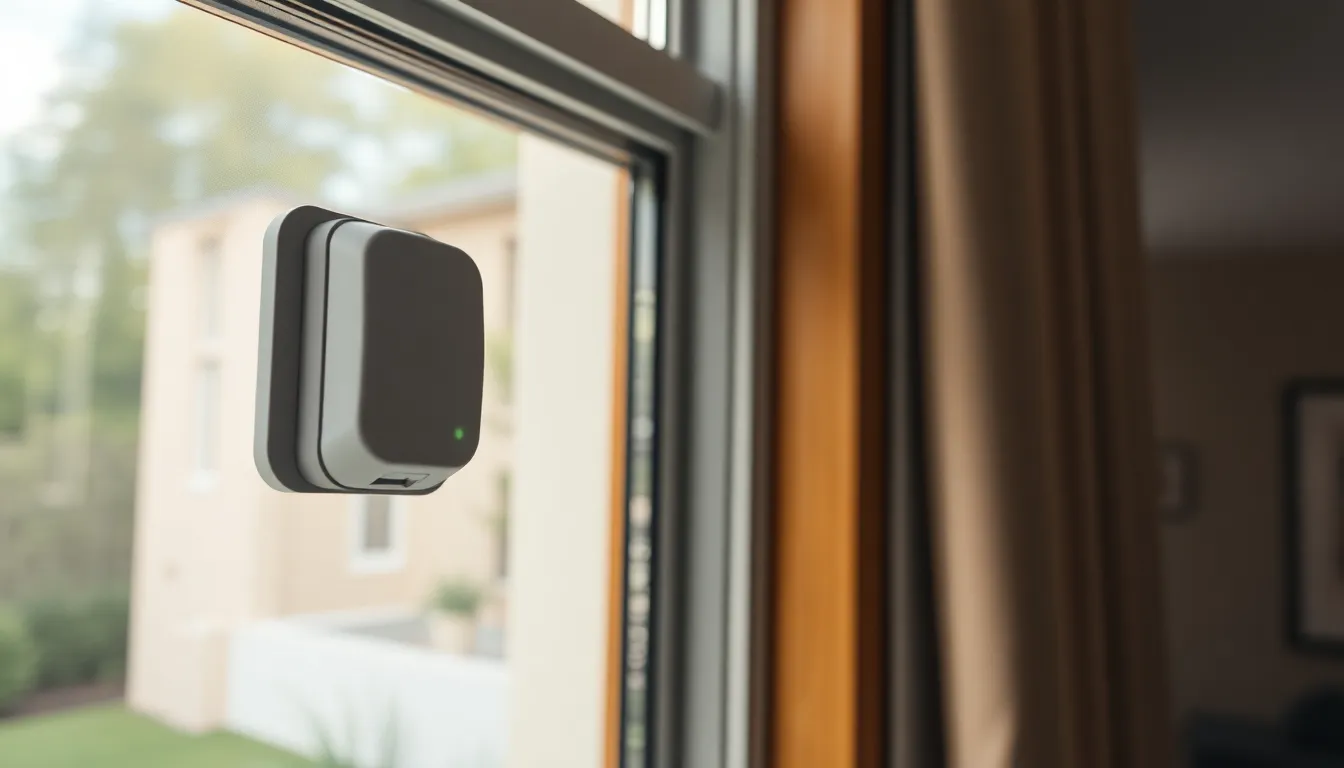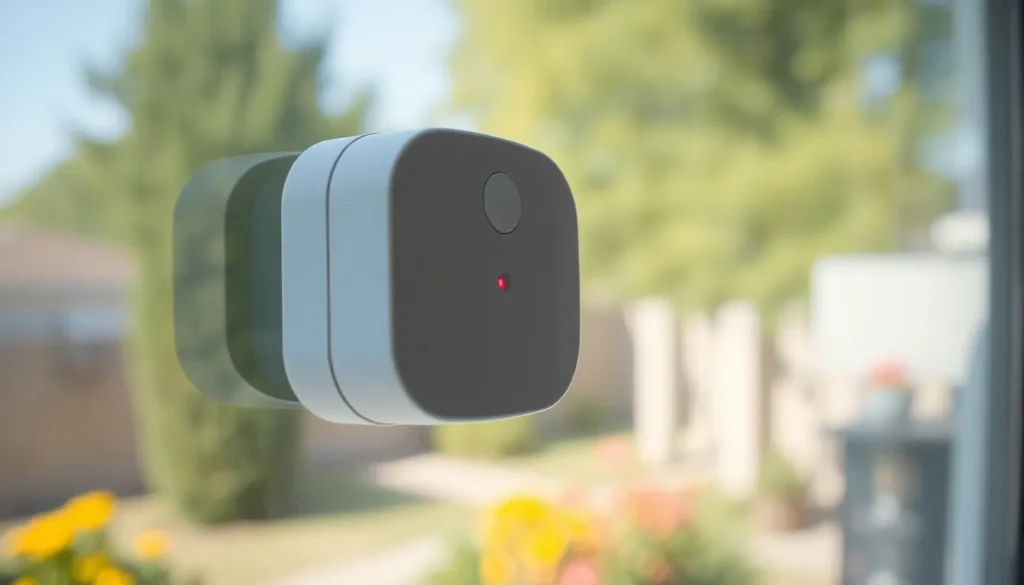In a world where security is paramount, window break sensors are the unsung heroes of home protection. Imagine a tiny gadget that can detect the sound of shattering glass faster than you can say “burglar alert!” These devices aren’t just high-tech toys; they’re your home’s first line of defense against unwelcome intruders.
Table of Contents
ToggleOverview of Window Break Sensors
Window break sensors play a vital role in enhancing home security systems. These devices detect the specific frequencies associated with shattering glass, providing rapid alerts to homeowners or monitoring services. Installation typically occurs near windows to ensure optimal performance.
Different types of window break sensors exist, including glass break detectors and acoustic sensors. Glass break detectors include built-in microphones that analyze sound patterns. Acoustic sensors, on the other hand, utilize advanced algorithms to differentiate between glass-breaking sounds and other noises.
Effective detection capabilities contribute to the reliability of these sensors. A well-calibrated sensor can detect the sound of breaking glass from distances of up to 25 feet. In contrast, poorly calibrated devices may trigger false alarms due to unrelated sounds, such as loud music or thunderstorms.
Integration with home security systems enhances their effectiveness. Many sensors connect wirelessly to control panels or smart home hubs, allowing for streamlined monitoring and alerts. When paired with cameras and motion detectors, the security system provides comprehensive coverage and increased peace of mind.
Homeowners should consider placement to maximize sensor performance. Installing sensors on all windows significantly reduces entry points for potential intruders. Regular maintenance, including testing and ensuring batteries are charged, maintains optimal functionality.
Overall, window break sensors represent a proactive approach to home security. Investing in these devices strengthens household protection against break-ins, making them an essential component of modern security systems.
Types of Window Break Sensors

Various types of window break sensors enhance home security. Each type operates on distinct principles and offers unique advantages.
Acoustic Sensors
Acoustic sensors detect specific sound frequencies made by breaking glass. These devices utilize built-in microphones to listen for the sound of shattering glass. Advanced algorithms differentiate glass-breaking noises from background sounds. Accurate calibration allows these sensors to cover areas up to 25 feet away. Many models seamlessly integrate with existing security systems, providing immediate alerts when glass is broken. Homeowners benefit from their unobtrusive design, making them ideal for various window types.
Shock Sensors
Shock sensors respond to vibrations caused by glass breakage. These sensors attach directly to window frames and measure disruptions in the glass structure. When an impact occurs, they trigger an alarm, alerting homeowners of potential intrusions. Shock sensors often come with sensitivity settings, allowing customization based on window type or location. This adaptability increases reliability and prevents false alarms from environmental factors. Many units operate on battery power, ensuring functionality during power outages. Integration with alarm systems enhances overall security measures.
How Window Break Sensors Work
Window break sensors utilize advanced technology to detect the sound of shattering glass and alert homeowners promptly. These systems offer a reliable layer of protection against potential intrusions.
Detection Technology
Detection technology varies among window break sensors, including acoustic sensors and shock sensors. Acoustic sensors use built-in microphones to capture sound frequencies associated with breaking glass. They analyze these frequencies to ensure accurate detection. Shock sensors, on the other hand, attach directly to window frames and monitor vibrations in the glass. Both types of sensors demonstrate effectiveness in enhancing security measures, as they respond to distinct characteristics of glass breakage. While acoustic sensors excel at distinguishing glass sounds from background noise, shock sensors provide a more tactile approach to detection.
Signal Processing
Signal processing plays a vital role in ensuring reliable alerts from window break sensors. Acoustic sensors employ advanced algorithms to filter and analyze sound data. They focus on identifying specific frequency patterns that indicate glass being shattered. These algorithms improve accuracy by reducing false alarms caused by non-threatening noises. Signal processing in shock sensors involves measuring vibrations in real time. This method detects sudden changes in glass structure that indicate potential breakage. Together, these processes enable sensors to provide immediate alerts, enhancing the overall security of homes. Each technology contributes to a comprehensive home safety strategy.
Benefits of Using Window Break Sensors
Window break sensors provide significant advantages for enhancing home security. Early detection of glass breakage plays a crucial role in preventing unauthorized entries. Intruders face a higher risk of being caught when alarms trigger almost immediately following a break.
Rapid alerts ensure homeowners can respond quickly to potential threats. Many systems send notifications directly to smartphones or central monitoring stations. This immediate communication allows for timely intervention, whether through contacting authorities or checking the property.
Integration with existing security systems enhances overall protection. Combining window break sensors with surveillance cameras creates a robust security network. Such integration allows for real-time footage to coincide with alarm activation, providing vital context during a security incident.
Sensitivity options further enhance user customization. Different environments may require unique settings based on factors like window type or surrounding noise. Adjustable sensitivity can minimize false alarms while maintaining effective monitoring.
Regular maintenance guarantees reliable performance. Ensuring sensors remain calibrated and functional is essential for optimal operation. Routine checks help identify potential issues, allowing homeowners to address them before they compromise security.
Cost-effectiveness ranks high among the benefits. Investing in window break sensors often leads to lower home insurance premiums. Insurance providers may offer discounts to homeowners who take proactive measures toward security, reflecting the long-term financial advantages of these devices.
Peace of mind represents another key benefit. Knowing that windows are monitored against breakage enables a sense of security. Homeowners can feel confident in their safety, especially when away from home, allowing for greater freedom and less anxiety.
Considerations When Choosing Window Break Sensors
When selecting window break sensors, various factors must be evaluated. Prioritize detection range; many sensors can effectively identify breaking glass from distances up to 25 feet. Consider installation ease; some models allow quick setup without professional assistance.
Sensitivity options play a vital role. Users can adjust settings based on window type or typical noise levels, ensuring accurate performance without frequent false alarms. Different sensor technologies provide unique advantages. Acoustic sensors utilize built-in microphones to differentiate breaking glass sounds, while shock sensors monitor vibrations in window frames.
Evaluate integration capabilities with existing security systems. Many window break sensors connect seamlessly with control panels or smart hubs, providing cohesive monitoring. Compatibility with surveillance cameras enhances overall security, offering real-time alerts and context during incidents.
Cost should not be overlooked. Quality window break sensors offer a cost-effective solution, potentially lowering home insurance premiums due to enhanced security. Maintenance frequency also matters; regular checks help maintain sensor calibration and functionality.
Another important aspect is user notifications. Rapid alerts sent directly to smartphones or monitoring stations ensure quick homeowner responses. Consider warranty and support options as well, as these can provide peace of mind during the product lifecycle.
Choosing the right window break sensor involves careful analysis of features, installation, and compatibility. Assessing these considerations leads to informed choices that enhance home security.
Window break sensors play a vital role in enhancing home security. Their ability to detect the sound of breaking glass provides homeowners with an immediate alert to potential threats. This early detection not only helps prevent unauthorized entries but also increases the chances of apprehending intruders.
With various types of sensors available homeowners can choose options that best fit their needs. The integration of these sensors into existing security systems creates a more comprehensive approach to safeguarding properties. Regular maintenance and proper placement ensure optimal performance.
Investing in window break sensors offers peace of mind and can even lead to cost savings on home insurance. By prioritizing security measures like these sensors homeowners can create a safer living environment for themselves and their families.













